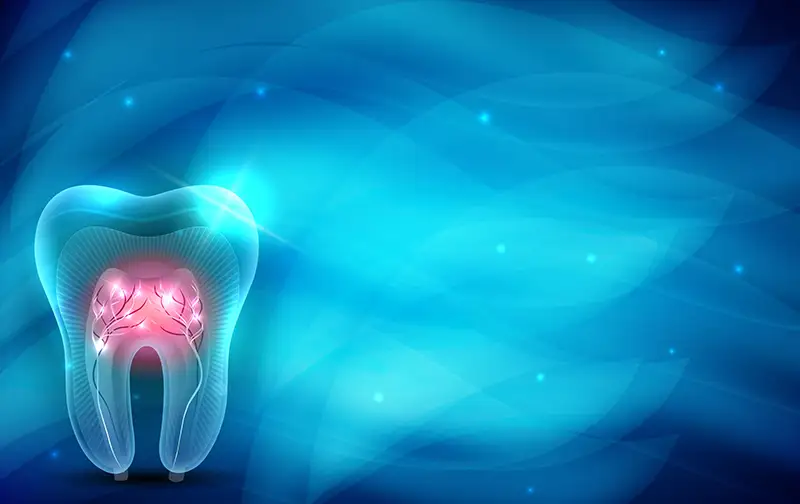What Causes Pulp Infection? Pulp infection, also known as pulpitis, is a painful condition that occurs when the soft inner tissue of a tooth becomes inflamed or infected. The innermost part of the tooth is called the dental pulp. It contains nerves, blood vessels, and connective tissues that are vital to tooth development in children, but may lead to pulp infection in adults. The soft pulp is very vulnerable to infection when the outer enamel of the tooth has been compromised by injury or decay. This may lead to infection, pulp necrosis, or tooth loss if left untreated. Pulp infection, also known as pulpitis, is a painful condition that occurs when the soft inner tissue of a tooth becomes inflamed or infected. The innermost part of the tooth is called the dental pulp. It contains nerves, blood vessels, and connective tissues that are vital to tooth development in children, but may lead to pulp infection in adults. The soft pulp is very vulnerable to infection when the outer enamel of the tooth has been compromised by injury or decay. This may lead to infection, pulp necrosis, or tooth loss if left untreated.Understanding Dental PulpThe dental pulp is protected by the hard outer layers of the tooth called the enamel and dentin. In a healthy tooth, these layers guard the vulnerable pulp against bacteria and other harm. However, when the enamel and dentin layers are compromised by injuries or decay, it allows bacteria to invade the pulp, which causes inflammation and infection. If left untreated, the infection may spread, and can even become systemic. Primary Causes of Pulp InfectionSeveral dental problems may lead to pulp infection: Tooth DecayTooth decay is the most common cause of pulpitis. When bacteria in the mouth feed on sugars and produce acid, it erodes the enamel and dentin, and creates cavities. If these cavities are left untreated, they can deepen and eventually reach the pulp, which allows the bacteria to cause infection. Good oral hygiene is the first line of defense against cavities. Dental TraumaPhysical injury to a tooth is the second most common cause of pulp infection. This can include:
These injuries can create pathways for bacteria to enter the pulp or cause direct damage to the pulp tissue itself. Patients can protect themselves against these injuries:
Risk Factors for Pulp InfectionSeveral factors may increase the risk of pulp infection: Poor Oral HygieneInadequate brushing and flossing allows bacteria to accumulate on teeth and increases the risk of decay, pulp infection, and periodontal (gum) disease. The best defense against pulpitis is diligent oral hygiene habits at home, and regular dental checkups. High Sugar DietConsuming foods and drinks high in sugar feeds bacteria in the mouth, accelerates tooth decay, and the risk of infection. Dry MouthDry mouth can increase the risk of tooth decay. This is because saliva helps to neutralize acids and wash away food particles in the mouth. Medical ConditionsCertain medical conditions such as diabetes can increase susceptibility to infections, including those in the dental pulp. The Progression of Pulp InfectionUnderstanding how pulp infection develops helps our patients to recognize the symptoms, and work with our team to prevent the condition. Initial InflammationWhen irritants first reach the pulp, it responds with inflammation. This early stage is known as reversible pulpitis, and is identified by increased sensitivity to temperature. If reverse pulpitis is diagnosed and addressed quickly, the pulp can recover. Irreversible PulpitisWhen the irritation from bacteria continues, the inflammation progresses to irreversible pulpitis. At this stage, the pulp's ability to heal itself is compromised. The increased pressure within the tooth can lead to severe pain, especially when biting or applying pressure. Pulp NecrosisLeft untreated, irreversible pulpitis can lead to pulp necrosis, where the pulp tissue dies. This can result in a cessation of pain as the nerves die, but it allows the infection to spread beyond the tooth root. The Role of Bacteria in Pulp InfectionBacteria plays a crucial role in the development of pulp infections. Streptococcus mutans is typically the first strain to enter the pulp and start the inflammation. As the infection progresses, other bacteria make their way into the pulp, then release toxins, enzymes, and acids that further damage the pulp tissue. Physical Effects of Pulp InfectionThe process of pulp infection involves complex physical changes to the tooth, including: Vascular ChangesWhen irritants reach the pulp, they increase blood flow to the area. Pressure IncreasesThe dental pulp is enclosed in a rigid chamber, and unable to relieve pressure. As inflammation worsens, the increased blood flow leads to more and more pressure within the tooth. Pain SignalingThe increased pressure and inflammation causes the intense pain of pulp infection. Complications of Untreated Pulp InfectionIf a pulp infection is not addressed, it can lead to several serious complications: Periapical AbscessThe infection can spread beyond the tooth root and form a pocket of pus in the surrounding bone. This can cause even more pain and swelling. Bone LossChronic infection can lead to bone deterioration, and changes to the structure of the face. Systemic SpreadIn rare cases, untreated dental infections spread to other parts of the body. Prevention of Pulp InfectionPractice good oral health to prevent pulpitis:
Understanding PulpitisPulp infection is a serious dental condition with multiple potential causes, ranging from untreated decay to physical trauma. Understanding these causes and risk factors is crucial to prevent pulpitis, and to ensure early detection and intervention. The tooth pulp has remarkable healing capabilities, but once the infection has gone too far, professional dental treatment becomes necessary to save the tooth and prevent further complications. Regular dental care, good oral hygiene, injury prevention, and prompt attention to dental issues are the best defenses against pulp infection and its consequences. If you believe that you have a pulp infection, please contact the Duggan Endodontics team today at (512)-380-0777. |